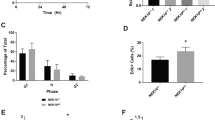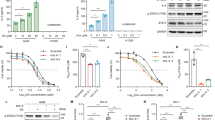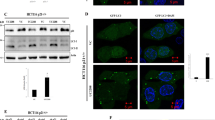Abstract
p53 is a tumor suppressor that responds to various stress signals by initiating cell-cycle arrest, senescence and apoptosis. Mutations of the p53 gene are found in over 50% of human tumors, highlighting the importance of p53 in tumor suppression. Numerous studies have reported on the interactions between p53, IGF-1–AKT and mTOR pathways as potentially explaining some of the tumor suppressive activities of p53. To further understand the basis of these interactions, we analyzed the involvement of DJ-1, an oncogene known to drive AKT-mediated cell survival, in the p53–AKT axis. In this study, we show that DJ-1 and p53 are tightly ‘linked’: p53 prevents the accumulation of DJ-1 protein, whereas loss of p53 leads to stabilization and enhancement of DJ-1 expression. Interestingly, this increase in DJ-1 level is only observed when p53 loss is accompanied by transformation of cells. Moreover, DJ-1 seems to be required for the enhanced activation of AKT observed in p53-deficient cells. Such observation confers a new property to DJ-1 associated to transforming-process to its oncogenic ability to drive AKT activation. We also show that DJ-1 is necessary for p53 activation following oxidative stress, suggesting the existence of a finely regulated loop between these two proteins in transformed cells. Finally, we demonstrate that in the absence of p53, DJ-1 is stabilized by ROS accumulation, and surprisingly seems to be required for this high intracellular ROS production. These data offer new insights into the regulation of DJ-1 and suggest that DJ-1 is a target of p53. Importantly, our study highlights that during transformation, DJ-1 is having a key role in the p53-regulated AKT pathway and p53-driven oxidative-stress response.
This is a preview of subscription content, access via your institution
Access options
Subscribe to this journal
Receive 50 print issues and online access
$259.00 per year
only $5.18 per issue
Buy this article
- Purchase on Springer Link
- Instant access to full article PDF
Prices may be subject to local taxes which are calculated during checkout




Similar content being viewed by others
References
Aleyasin H, Rousseaux MW, Marcogliese PC, Hewitt SJ, Irrcher I, Joselin AP et al. (2010). DJ-1 protects the nigrostriatal axis from the neurotoxin MPTP by modulation of the AKT pathway. Proc Natl Acad Sci USA 107: 3186–3191.
Cano CE, Gommeaux J, Pietri S, Culcasi M, Garcia S, Seux M et al. (2009). Tumor protein 53-induced nuclear protein 1 is a major mediator of p53 antioxidant function. Cancer Res 69: 219–226.
Dong P, Xu Z, Jia N, Li D, Feng Y . (2009). Elevated expression of p53 gain-of-function mutation R175H in endometrial cancer cells can increase the invasive phenotypes by activation of the EGFR/PI3K/AKT pathway. Mol Cancer 8: 103.
Fan J, Ren H, Fei E, Jia N, Ying Z, Jiang P et al. (2008). Sumoylation is critical for DJ-1 to repress p53 transcriptional activity. FEBS Lett 582: 1151–1156.
Feng Z . (2010). p53 regulation of the IGF-1/AKT/mTOR pathways and the endosomal compartment. Cold Spring Harb Perspect Biol 2: a001057.
Giaime E, Sunyach C, Druon C, Scarzello S, Robert G, Grosso S et al. (2010). Loss of function of DJ-1 triggered by Parkinson′s disease-associated mutation is due to proteolytic resistance to caspase-6. Cell Death Differ 17: 158–169.
Gottlieb TM, Leal JF, Seger R, Taya Y, Oren M . (2002). Cross-talk between Akt, p53 and Mdm2: possible implications for the regulation of apoptosis. Oncogene 21: 1299–1303.
Guzman JN, Sanchez-Padilla J, Wokosin D, Kondapalli J, Ilijic E, Schumacker PT et al. (2010). Oxidant stress evoked by pacemaking in dopaminergic neurons is attenuated by DJ-1. Nature 468: 696–700.
Hao LY, Giasson BI, Bonini NM . (2010). DJ-1 is critical for mitochondrial function and rescues PINK1 loss of function. Proc Natl Acad Sci USA 107: 9747–9752.
Hinkle DA, Mullett SJ, Gabris BE, Hamilton RL . (2011). DJ-1 expression in glioblastomas shows positive correlation with p53 expression and negative correlation with epidermal growth factor receptor amplification. Neuropathology 31: 29–37.
Johnson P, Chung S, Benchimol S . (1993). Growth suppression of Friend virus-transformed erythroleukemia cells by p53 protein is accompanied by hemoglobin production and is sensitive to erythropoietin. Mol Cell Biol 13: 1456–1463.
Kahle PJ, Waak J, Gasser T . (2009). DJ-1 and prevention of oxidative stress in Parkinson′s disease and other age-related disorders. Free Radic Biol Med 47: 1354–1361.
Kim RH, Peters M, Jang Y, Shi W, Pintilie M, Fletcher GC et al. (2005). DJ-1, a novel regulator of the tumor suppressor PTEN. Cancer Cell 7: 263–273.
Marcondes AM, Li X, Gooley TA, Milless B, Deeg HJ . (2010). Identification of DJ-1/PARK-7 as a determinant of stroma-dependent and TNF-alpha-induced apoptosis in MDS using mass spectrometry and phosphopeptide analysis. Blood 115: 1993–2002.
Nagakubo D, Taira T, Kitaura H, Ikeda M, Tamai K, Iguchi-Ariga SM et al. (1997). DJ-1, a novel oncogene which transforms mouse NIH3T3 cells in cooperation with ras. Biochem Biophys Res Commun 231: 509–513.
Nister M, Tang M, Zhang XQ, Yin C, Beeche M, Hu X et al. (2005). p53 must be competent for transcriptional regulation to suppress tumor formation. Oncogene 24: 3563–3573.
Rahman-Roblick R, Hellman U, Becker S, Bader FG, Auer G, Wiman KG et al. (2008). Proteomic identification of p53-dependent protein phosphorylation. Oncogene 27: 4854–4859.
Sablina AA, Budanov AV, Ilyinskaya GV, Agapova LS, Kravchenko JE, Chumakov PM . (2005). The antioxidant function of the p53 tumor suppressor. Nat Med 11: 1306–1313.
Shenkman M, Tolchinsky S, Kondratyev M, Lederkremer GZ . (2007). Transient arrest in proteasomal degradation during inhibition of translation in the unfolded protein response. Biochem J 404: 509–516.
Stambolic V, MacPherson D, Sas D, Lin Y, Snow B, Jang Y et al. (2001). Regulation of PTEN transcription by p53. Mol Cell 8: 317–325.
Tomasini R, Tsuchihara K, Wilhelm M, Fujitani M, Rufini A, Cheung CC et al. (2008). TAp73 knockout shows genomic instability with infertility and tumor suppressor functions. Genes Dev 22: 2677–2691.
Vasseur S, Afzal S, Tardivel-Lacombe J, Park DS, Iovanna JL, Mak TW . (2009). DJ-1/PARK7 is an important mediator of hypoxia-induced cellular responses. Proc Natl Acad Sci USA 106: 1111–1116.
Vasseur S, Hoffmeister A, Garcia S, Bagnis C, Dagorn JC, Iovanna JL . (2002). p8 is critical for tumour development induced by rasV12 mutated protein and E1A oncogene. EMBO Rep 3: 165–170.
Vousden KH, Prives C . (2009). Blinded by the light: the growing complexity of p53. Cell 137: 413–431.
Waak J, Weber SS, Gorner K, Schall C, Ichijo H, Stehle T et al. (2009). Oxidizable residues mediating protein stability and cytoprotective interaction of DJ-1 with apoptosis signal-regulating kinase 1. J Biol Chem 284: 14245–14257.
Wilhelm MT, Rufini A, Wetzel MK, Tsuchihara K, Inoue S, Tomasini R et al. (2010). Isoform-specific p73 knockout mice reveal a novel role for delta Np73 in the DNA damage response pathway. Genes Dev 24: 549–560.
You H, Jang Y, You-Ten AI, Okada H, Liepa J, Wakeham A et al. (2004). p53-dependent inhibition of FKHRL1 in response to DNA damage through protein kinase SGK1. Proc Natl Acad Sci USA 101: 14057–14062.
Zhan H, Suzuki T, Aizawa K, Miyagawa K, Nagai R . (2010). Ataxia telangiectasia mutated (ATM)-mediated DNA damage response in oxidative stress-induced vascular endothelial cell senescence. J Biol Chem 285: 29662–29670.
Acknowledgements
We thank P Spoto and K Sari for technical assistance. S Vasseur, R Tomasini, and J Tardivel-Lacombe were supported by Institute National de la Santé et de la Recherche Médicale France. F Guillaumond was supported by the ‘Fondation Santé, Sport et développement durable’. S Vasseur and S Afzal were supported by the Canadian Institute of Health Research. This work was also supported by grants from the ‘Ligue Contre le Cancer’, France and the ‘Institut National du Cancer (INCa)’, France.
Author information
Authors and Affiliations
Corresponding authors
Ethics declarations
Competing interests
The authors declare no conflict of interest.
Rights and permissions
About this article
Cite this article
Vasseur, S., Afzal, S., Tomasini, R. et al. Consequences of DJ-1 upregulation following p53 loss and cell transformation. Oncogene 31, 664–670 (2012). https://doi.org/10.1038/onc.2011.268
Received:
Revised:
Accepted:
Published:
Issue Date:
DOI: https://doi.org/10.1038/onc.2011.268
Keywords
This article is cited by
-
ASF1 regulates asexual and sexual reproduction in Stemphylium eturmiunum by DJ-1 stimulation of the PI3K/AKT signaling pathway
Fungal Diversity (2023)
-
DJ-1 promotes colorectal cancer progression through activating PLAGL2/Wnt/BMP4 axis
Cell Death & Disease (2018)
-
Park7 interacts with p47phox to direct NADPH oxidase-dependent ROS production and protect against sepsis
Cell Research (2015)
-
Modulation of oxidative stress as an anticancer strategy
Nature Reviews Drug Discovery (2013)
-
DJ-1 protein expression as a predictor of pathological complete remission after neoadjuvant chemotherapy in breast cancer patients
Breast Cancer Research and Treatment (2013)



